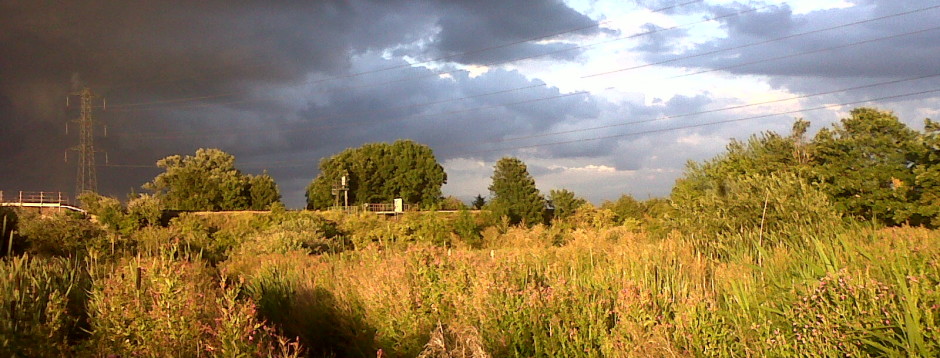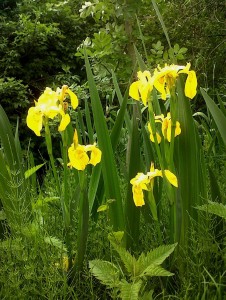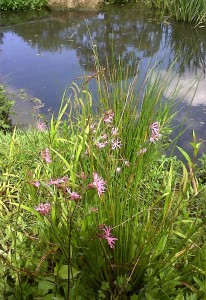Six members plus a friend joined me as leader on this late spring wildlife walk organised by Friends of the Shuttle, the wildlife/environment action group in the park, looking primarily at plants, damselflies and birds.
Some of the plants of interest that I had hoped to point out were unfortunately in the process of being run over with the Council contractor’s tractor-hauled mowers, so no sign of Subterranean Clover flowers, and even the Lesser and Slender Trefoils were not evident near the lakeside route we took. Gone-over Clustered Clover flower heads were examined, an uncommon plant in London but quite common in parts of Bexley. A Knotted Clover was found in flower after the meeting. Meadow, Creeping and Bulbous Buttercups were compared, the latter displaying its reflexed sepals and propensity to thrive amongst Daffodils planted in grass where it can flower before the bulb’s leaves fully die back and the whole lot is cut down. The umbellifers Cow Parsley, Pignut, Fool’s Watercress and Hemlock Water Dropwort were compared and it was pointed out that some of these carrot family plants are perfectly edible whilst others are poisonous. The differences between Smooth and Spiny Sow-thistle were looked at. Flag Irises were out in profusion. The only other native Iris, the Stinking or Gladwyn Iris, was on the dam wall, probably planted or a garden escape.
Various small Speedwells were in flower. The trick of reversing binoculars to create a makeshift magnifying glass, new to those present, was used to examine the attractive small white, violet-streaked flowers of Thyme-leaved Speedwell. Another, from the ‘arboretum’ area, identified after the meeting from a collected specimen, was the creeping perennial Heath Speedwell (Veronica officinalis), not a plant I’ve recorded in the park before from my rather hit-and-miss botanising of the site. The showy China-blue flowers of Germander Speedwell, which has a distinctive row of hairs down each side of the stem at 180 degrees to each other were near the south-east corner of the lake.
There was now a large amount of Ragged Robin in flower by the rock garden pond, along with Watercress, Brooklime (another kind of Speedwell) and Mimulus.
Lesser Stitchwort, which I don’t recall seeing at Danson before, was in flower near the woodland at the west end of the park.
The changeable weather and surprisingly stiff, quite cool breezes were not ideal for Odonata activity, but quite a few Common Blue, Azure and Blue-tailed damselflies were active in long grasses around islands of trees in the otherwise mown area north of the lake. Some pairs were in tandem, so breeding is underway. I caught a male Common Blue to show the club-shaped mark at the top of the abdomen, as distinct from the square ‘U’ shape of the male Azure. After everyone else left the sun came out for bit longer for a while and I found a Large Red Damselfly, the first (Large) Red-eyed Damselfly I’ve seen this year and my first Broad-bodied Chaser for the site.
Only two butterflies were seen, both Speckled Woods, though a male Common Blue butterfly was in the Old English Garden after the meeting. It was explained that the powder blue butterflies now often seen in gardens in the area at this time of year are primarily the Holly Blue, though Common Blue can turn up.
Some of the birds seen were a Jay, Stock Dove, Grey Heron, a confiding Robin with a damaged leg, Tufted Ducks, 2 Cormorant, a Great Crested Grebe and 3 Swift. There was a discussion of hybridisation between Mallards and various domesticated ducks, often leading to male Mallards with a rather ‘harlequin’ look to them. To round things off, a Pied Wagtail was fluttering about on mats of algae at the end of the lake catching insects.
We didn’t get to see quite the array of things I’d hoped for, but like most sites, the more you visit, the more you get out of it.
Chris Rose


